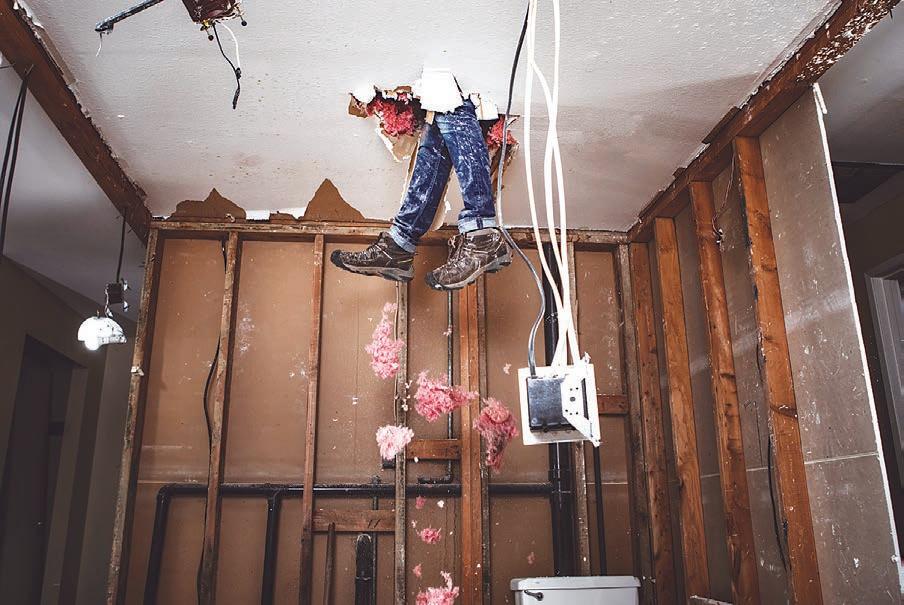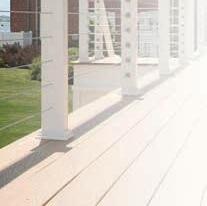

Why it pays to hire contractors for home renovations
A sense of pride comes from a successful do-it-yourself home improvement project. However, quite often inexperience and time constraints lead homeowners to turn to professional contractors to make sure jobs get done correctly and on time.
Allied Market Research reported in 2021 that the home improvement services market is predicted to reach $585.3 billion by 2030. The following are some reasons why renovation-minded homeowners benefit from the services of professionals.
• Tasks can be overwhelming: A home remodel is a large undertaking with many different steps. Contractors who have been around the block a time or two understand how to organize and manage time to get the job done. Plus, they’re
devoting all of their attention and time toward the remodel when on the job. This differs from when a do-ityourselfer tries to work on a remodel in between other responsibilities.
• Network of suppliers: A good general contractor will have a list of material suppliers he or she routinely uses. Often contractors become preferred sellers, which means they get a lower wholesale rate, and will often pass those savings on to the customer.
• Licensed and bonded protection: Licensed and bonded contractors not only have the skills for the job, they have insurance protection behind them. Therefore, if an injury occurs or the job goes awry, the homeowner will be protected from liability. A license means the contractor will have to uphold

licensing standards, which could mean staying current on trade practices and skills.
• Expertise: Experienced contractors have done the work they have been hired to do many times, which means their skills are fine-tuned. Knowing the correct way to do a job results in fewer errors (and thus fewer repairs), shorter time periods to get the work done, and potentially lower costs overall.
• Frees up time: Homeowners who hire out for remodels can utilize their time in other ways, such as on the job or spending time with family.

• Reduces stress: Putting the work in capable hands means homeowners do not have to educate themselves about how to do the task, purchase tools, prevent injuries, and/or deal with potentially negative outcomes. Certainly having extra peo-
lenging, but it may not equal the stress caused by tackling a job on one’s own.
es to hiring contractors to renovate a home instead of taking the DIY route.

(800)207-5555 www.Greylock.org

‘Closingcostspaidonborrower’sbehalf.BorrowermayberesponsibleforrepaymentofcosttoGreylockifloanisclosedorrefinancedwithin36months.Offersubject tocreditapproval.PrimeRateaspublishedintheWallStreetJournal.Maximumloan-to-value(LTV)of80%toobtainthePrimeRateminus1.00%promotionalrate offer.Otherrestrictionsmayapply.PromotionalrateofPrimeminus1.00%availablefor12monthlybillingcycles.Afterpromotionalrateperiodends,ratewillrevertto thethencurrentvariablerateofPrimeplus0.00%.Otherratesandtermsavailable.InsuredbyNCUA.




















“Ineededalittlehelptoturnourhouseintoourdream home.MyHomeEquityLineofCreditsavedtheday. Applyingwaseasy,theclosingwasquick,andGreylock exceededeveryexpectation.”METRO CREATIVE CONNECTION
The benefits of energy-efficient homes
Consumer efforts to be more eco-conscious are more and more noticeable. For proof of that, one need look no further than the increase in vehicle charging stations. Such stations are more accessible than ever and illustrate that consumer preference is increasingly leaning toward products that leave as small a carbon footprint as possible.
Another indicator of a growing interest in eco-friendly products is the popularity in energy-efficient homes. In fact, a recent survey from the National Association of Home Builders found that energy-efficient features are among the most sought-after “must-haves” among homebuyers. Among those surveyed, 83 percent desired Energy Star-rated windows, 81 percent wanted Energy Star-rated appliances and 80 percent preferred energy-efficient lighting.
Though eco-conscious sensibilities compel millions of homeowners to make their homes more energy-efficient,


lowing are a handful of the many benefits of energy-efficient homes.


• Save money: Inflation was one of the biggest stories of 2022, as the cost of living rose dramatically in the wake of world events. According to data from the U.S. Bureau of Labor Statistics, inflation led to an overall 6.5 percent
cost of electricity, which increased by 14.3 percent in 2022. Energy-efficient appliances can help homeowners overcome that spike, as the U.S. Department of Energy indicates upgrading to such products can help homeowners reduce their energy costs by as much as 30 percent.
• Improve resale value: As the


gy-efficient homes. They’re also willing to pay more for such homes. Research from the mortgage lender Freddie Mac found that homes with energy-efficient ratings sold for nearly 3 percent more on average than homes without such ratings.
• Live healthier: The benefits of energy-efficient homes


aren’t just economic, though health-related benefits certainly produce an economic incentive as well. According to the American Council for an Energy-Efficient Economy, insulation and air sealing protect individuals from heat waves and other ripple effects of climate change. The ACEEE notes that weatherization can improve indoor air quality and comfort, a notable benefit for asthma sufferers and seniors. In fact, the ACEEE estimates that integrating energy efficiency programs in homes could reduce seniors’ risk for falls in their homes, potentially saving $2 billion in fall-related health care costs over the next decade, and improve asthma outcomes, which could reduce health care costs by as much as half a billion dollars.
Energy-efficient products and practices pay numerous dividends, making them a worthy expenditure for any homeowners looking to upgrade their homes.
Minor exterior upgrades that can help sell a home

The home improvement industry has been booming for years, but forecasters are projecting a deceleration in 2023 and perhaps beyond.
Estimates from the Home Improvement Research Institute, which is the leading market research resource for the home and building products industry, indicate that growth in the home improvement products market is expected to decelerate from 7.2 percent in 2022 to 1.5 percent in 2023. Inflation continues to affect consumer spending, and homeowners may be looking to spend less on renovations in the year ahead.
Minor upgrades that aren’t as costly as larger projects can still make a big difference, especially among prospective buyers. When looking for minor upgrades that can help sell a home, homeowners can rely on Remodel-


ing magazine’s annual “Cost vs. Value Report.” That report analyzes costs for an assortment of remodeling projects and determines the value of those projects at resale. Though resale value depends on a host of variables, including location, the following are some relatively minor exterior upgrades that impress buyers and provide a strong return for homeowners.
• Garage door replacement: Garage doors matter more than sellers may recognize, as various real estate professionals note that buyers appreciate homes with updated garage doors. That’s good news for homeowners, as the “2022 Cost vs. Value Report” indicated homeowners recoup roughly 93 percent of their garage door replacement investment at resale. The average cost of such a job is right around $4,000,
making this a budget-friendly remodeling project.
• Window replacement: cost of new windows will pend on just how many windows must be replaced. But there’s no denying buyers like the idea of low emissivity (low-E) windows, which can cut energy bills by a signifi cant amount over time. The Office of Energy Effi Renewable Energy estimates that heat gain and heat loss through windows is responsible for between 25 and 30 percent of residential heating and cooling energy use, so sellers who can tell buyers they have new low-E windows can emphasize those savings in home listings. The “2022 Cost vs. Value Report” indicates that homeowners recoup roughly two-thirds of their investment in new windows at resale.

tained landscaping is another home exterior component that can make a strong first impression on buyers. A recent survey of nearly 7,000 realtors conducted by the National Association of Realtors found that upgrading a landscape recouped roughly 83 percent of homeowners’ ini-
addition, 11 percent of realtors surveyed indicated that an upgraded landscape was the decisive factor that closed the deal for the house.
Updating a home’s exterior doesn’t have to bust homeowners’ budgets. Many affordable projects also provide a substantial return at resale.
Give your home a new look with these shutter styles


Window shutters lend a finished and distinctive look to a home
Homeowners have many options at their disposal if they want to improve their homes. A focus on the exterior can be a promising and rewarding way to direct renovation dollars.
Curb appeal has a significant impact on how a home is viewed. Manicured landscapes, updated windows and doors and well-lit landscapes can improve the value of a home and ensure it sells quickly and above market rate.




When homeowners assess items they may want to change, shutters can be an area of consideration. Shutters can help windows look a little less plain. In most modern residential properties, shutters are purely decorative. However, their roots lie in home protection. Originally, shutters were used in lieu of windows so they were the only way to safeguard a home’s interior from the elements. Some shutters still offer that protection, but those typically are installed on homes in hurricane-prone areas.
Window shutters lend a finished and distinctive look to a home. When shopping for shutters, individuals can choose among various styles.
• Louvered: A louvered shutter features several wood slats that overlap each other on the same frame. A typical louvered shutter features two sets of slats separated by a center rail. Some functional louvered shutters are operational, meaning the slats can be tilted to allow air to flow through. But this is something typically reserved for
indoor shutters. Decorative ones have fixed slats.
• Panel: Panel shutters come in different styles. Raised panel shutters present a boxed design where rectangular features will stand out from the rest of the frame. Flat panel shutters (sometimes referred to as shaker) have the boxed design, but those rectangles are not raised. Recessed panels are the opposite of raised panels. As their name suggests, recessed panels are set back from the rest of the frame.
• Board and batten: Board and batten shutters are formed from grouped single boards joined together with shorter crosspieces of wood called battens. Battens are positioned horizontally or at an angle. These shutters have a more informal, rural feel.
• Bahama/Bermuda: These tropical-inspired shutters are of the louvered variety, but they’re installed from the top of the window rather than on the sides.
• Scandinavian: Scandinavian series shutters are very decorative board and batten shutters. They feature a series of cutouts and designs.
• Combination: Some shutters offer the best of both worlds, with louvered on top and a solid panel on the bottom, or vice versa. This gives homeowners infinite options.
Shutters are available in various materials. The most common include wood, vinyl and composite. Cedar, mahogany and pine are commonly used woods for exterior shutters. Vinyl is more economical and lightweight,


but they can be challenging to clean and do not offer the longevity of other materials. Composite shutters are durable and cost less than wood in most cases. Color is another consideration when replacing shutters. Shutters can stand out or blend in with the siding and other architectural accents. Shutters also can flank a front door to fully complete an exterior look.




YouwillfindagreatselectionoflandscapesupplieshereatWhitney’sFarmMarket.Whetheryouarea landscapecontractor,orado-it-yourselfhomeowner,weareyouronestopshopforallofyourlandscape projectsupplies.Thisincludesmulch,topsoil,compost,decorativestone,pavestonepaversandwall block,naturalstone,andbaggedproductstomatch.Weofferdeliveryforallofourbulkyardproducts.
Toplaceabulkmulchordercontactusnow(413)442-4749

The basics of fertilizing a lawn

Spring marks the return of lawn and garden season. Lawns often bear the brunt of winter’s wrath, so spring is a great time to nurse them back to health, and fertilizing can be an essential component of that process.
Fertilizing a lawn can be intimidating. An array of fertilizers, with each seemingly designed to address a different issue, can make homeowners’ heads spin when visiting their local lawn and garden center. However, fertilizing is a very simple task that any homeowner can tackle. In fact, fears about fertilizing are often unfounded and can be overcome with some basic knowledge of the process.
• Identify which type of grass is in the yard. The home improvement experts at HGTV note that turfgrass is divided into two categories: cool-season grass and warm-season grass. A local lawn and garden center can help homeowners identify which type of grass is in the yard, and this often depends on location. Fescue, bluegrass and perennial ryegrass are some examples of cool-season grasses, while Bermuda, bahia, St. Augustine, and zoysia are considered warm-season grasses. Identifying which type of grass is in the lawn is important because that will indicate when to fertilize. Cool-season grasses are typically best fertilized in early spring, while warm-season lawns can benefit from an application just before especially warm temperatures arrive.
• Survey the lawn to identify which spreader to use. A small yard or a thriving
lawn with only a few bald or unsightly patches may not need a full application of fertilizer. In such instances, a hand spreader can suffice. For larger lawns and areas, a broadcast spreader is the ideal option. Spreaders have multiple settings, and the fertilizer package will indicate which setting to utilize when using the product.
• Test the soil prior to purchasing fertilizer. The lawn experts at Pennington® note that a simple soil test can reveal soil pH and phosphorous and potassium levels. Soil tests can be purchased at most home improvement stores and lawn and garden centers, and they can help homeowners determine which fertilizer will most benefit their lawns.

• Water the lawn prior to fertilizing. The experts at Scotts® recommend a good watering a few days prior to fertilizing a lawn. Such an approach ensures the soil is ready to accept the fertilizer once it’s applied.
• Follow the instructions carefully. Detailed instructions are typically provided on fertilizer product packaging. Once homeowners have identified and purchased the product they need, they can simply follow the instructions on the packaging, including how and when to water after application, which can make fertilizing less intimidating. Fertilizing in spring can help a lawn recover from the previous summer and winter, ensuring it’s lush and green when summer entertaining season arrives.

Fertilizing is a very simple task that any homeowner can tackle
Factors that can delay your renovation

Homeowners who decide to renovate one or more rooms in their homes may be excited about the changes that are in store. Even simple modifications to paint color or accessories can change the look of a space. Larger renovations can produce even more dramatic effects.
When contractors provide cost estimates, they may predict how long they expect the job to take from start to finish. It is impossible to plan for every scenario, however. Jobs may be delayed for various reasons, and it’s rarely the fault of the contractor. Here are some reasons a renovation could experience snags along the way.
• Preexisting conditions: Opening up walls or removing flooring could reveal hidden problems. These include prior insect damage, leaks and water issues, asbestos, mold, or even pests. The presence of unforeseen issues will require remediation that can extend the project timeline.

• Schedule backup: Contractors often have busy schedules. When one job experiences delays, that causes a domino effect on others on the calendar. Homeowners should realize that the estimated start date of their own project is just an estimate and not necessarily set in stone.

• Lack of materials: Builders sometimes have difficulty procuring materials from vendors. Whether it’s con-




crete or a special-order appliance, the contractor is at the mercy of the vendor. If there are shipping delays or other issues, the job will have to be pushed back. Many steps to a project hinge on the one before. For example, walls cannot be put up until electrical work and plumbing has been completed.
• Prior errors: Corrections may need to be made to what a previous contractor or even the homeowner did. Problems need to be fixed or they may compromise the look and safety of the project. Issues may arise if prior renovations were not done to code.
• Obtaining permits: The application process for obtaining permits can take anywhere from a few weeks to a few months depending on the municipality and the scale of the project. Long permit lead times can delay the start of the job.

• Weather: Mother Nature can affect everything from the availability of materials to the job itself, particularly if work is being done outdoors.


• Finances: The overall cost of the job may change, especially if issues arise during the work. If funds dry up, the project may stall.
Certain factors can affect how long a renovation project will take. Homeowners should know that timelines are estimates and not set in stone.
How to compare contractors’ bids
Home renovation projects are significant undertakings. It is common for homeowners who may not have the time nor the expertise to do the work themselves to call in professionals to tackle these jobs.
According to the home improvement resource HomeGuide.com, for a bathroom remodel, which is one of the more popular improvement projects, installation and labor accounts for 10 to 25 percent of the total project cost. In general, many contractors pay themselves $300 to $500 for an hourly rate, while helpers may make $150 per hour.

Materials used account for the other components of an overall project cost. Homeowners negotiate the best rates possible by obtaining a number of bids from contractors, spelling out both labor and material costs and determining their

best option. Here’s how to compare bids.
CHECK AS MANY REVIEWS AS POSSIBLE
Go online, ask friends for recommendations, or rely on the Better Business Bureau to find reliable contractors. A contractor who seems too good to be true will not necessarily be so, but it’s still best to vet each professional thoroughly prior to signing a contract.
COST BASIS VS BID BASIS
Certain contractors will produce an estimate based on the best guess of the cost of supplies then add on a flat fee or percentage for their services. This is called a cost basis bid. Others will create a bid that includes all their anticipated supply and labor costs, known as a bid basis bid. Know what you’re getting to make the most accurate comparison.
CREATE A MASTER ITEMIZED CHECKLIST
It’s easy to explain the project differently from one contractor to another when doing so verbally. That may result in a different plan and price. Rather, make a checklist of what you want done and have several copies to give to the contractors with whom you meet. This makes it easier to compare costs line by line.
Decking

HAVE SPECIFIC MATERIALS IN MIND
Make sure bids are based on the same materials and tasks. For example, if you’re comparing window replacement quotes, be sure that each quote is based on the same window material and coating. Vinyl replacement windows may not cost the same as fiberglass or wood.
It is much easier to compare pricing when contrac-

tors provide estimates reflecting the same materials.
SMALL VERSUS BIG CONTRACTING COMPANIES
Some bids may differ based on the manpower of the company. One contractor may view a project as an easy one that can be slipped right into the schedule. Another may have to devote more time and effort if it is being undertaken by one or two people. This can affect cost in the quote. Furthermore, a contractor who does a lot of advertising in print, television or online, or has an office or warehouse space, may have extra overhead costs that are passed on to the customer.
DOING YOUR OWN DEMO
Figure out if the contractor will allow you to perform a portion of the tear-out, clean-up or other tasks to save on labor costs. Make sure this is included in the bid.
Comparing contractor work bids can be tricky, but it helps homeowners know they’re getting the best value for their money.

Create your native plant garden
Gardening is a worthwhile endeavor that not only passes the time, but can be a form of exercise and relief from the daily grind. Gardens also provide ample opportunity to experiment, as individuals can produce everything from vegetables to bountiful blooms.
Recent years have witnessed a growing emphasis on eco-friendly gardening that aims to reduce reliance on chemical fertilizers and pesticides in an effort to protect the planet. One way to do so is to rely on native plants.

WHAT ARE NATIVE PLANTS?
Native plants are indigenous to particular regions. The National Wildlife Federation says native plants grow in habitats without human introduction or intervention. Native plants have formed symbiotic relationships with local wildlife over thousands of years, which the NWF notes makes them the most sustainable options. Native plants help the environment and thrive with little supplemental watering or chemical nutrients.
NATIVES VARY BY REGION
Native plants vary by region. In arid climates, certain succulents may be native because they don’t need much rainfall to thrive. In lush wetlands, succulents might be out of place.
START NATIVE PLANTING

The NWF offers native plants for 36 different states that can be shipped right to customers’ doors to help replenish native varieties. In addition, gardeners can visit local gardening centers to select native plants. Small and independently owned centers often feature knowledgeable local staff whose expertise can prove invaluable to individuals seeking native varieties.
It’s important to keep in mind that native varieties may look less cultivated than more exotic blooms and foliages designed to sell for their unique appearances. Wildflowers and native grasses
may be the types of native plants found in abundance, which may grow up and out quickly. These other tips can help the process.


• Plan and prepare the site by removing weeds and turning over the soil. This will give seedlings an opportunity to take root without competition from weeds. Seedlings will give gardens a faster head-start than waiting around for seeds to germinate. However, gardeners can start seeds indoors and then move them outside once they are seedlings.
• Avoid planting native plants in rows, as that’s not how they’re likely to grow naturally. Vary the placement so the plants look like they sprouted up haphazardly.
• Gardeners can still exert some control over native gardens prone to growing a little wild. Borders and paths can better define the growing areas.
• Grow Native!, an initiative from the Missouri Prairie Foundation, suggests planting two to four species in broad sweeping masses or drifts. Mix grasses with flowering plants. The grasses produce dense, fibrous roots that can prevent weed growth.
Native plants should require minimal care. Keep an eye on them and supplement with water if conditions have been especially dry.
How to make homes safer from fires



Over a five-year period beginning in 2015 and 2019, fire departments across the United States responded to roughly 347,000 home structure fires per year. That data, courtesy of the National Fire Protection Association, underscores the significance of home fire protection measures.




Smoke detectors are a key component of fire protection, but there’s much more homeowners can do to protect themselves, their families, their belongings, and their homes from structure fires.
• Routinely inspect smoke detectors. Smoke detectors can only alert residents to a fire if they’re working properly. Battery-powered smoke detectors won’t work if the batteries die. Routine smoke detector check-ups can ensure the batteries still have juice and that the devices themselves are still functioning properly. Test alarms to make sure the devices are functioning and audible in nearby rooms. Install additional detectors as necessary so alarms and warnings can be heard in every room of the house.
• Hire an electrician to audit your home. Electricians can inspect a home and identify any issues that could make the home more vulnerable to fires. Ask electricians to look over every part of the house, including attics and crawl spaces. Oft-overlooked areas like attics and crawl spaces pose a potentially significant fire safety threat, as data from the Federal Emergency Management Association (FEMA) indicates that 13 percent of electrical fires begin in such spaces.








• Audit the laundry room. The laundry room is another potential source of home structure fires. NFPA data



indicates around 3 percent of home structure fires begin in laundry rooms each year. Strategies to reduce the risk of laundry room fires include leaving room for laundry to tumble in washers and dryers; routinely cleaning lint screens to avoid the buildup of dust, fiber and lint, which the NFPA notes are often the first items to ignite in fires linked to dryers; and ensuring the outlets washing machines and dryers are plugged into can handle the voltage such appliances require. It’s also a good idea to clean dryer exhaust vents and ducts every year.



• Look outward as well. Though the majority of home fires begin inside, the NFPA reports that 4 percent of such fires begin outside the home. Homeowners can reduce the risk of such fires by ensuring all items that utilize fire, including grills and firepits, are always used at least 10 feet away from the home. Never operate a grill beneath eaves, and do not use grills on decks. Never leave children unattended around firepits, as all it takes is a single mistake and a moment for a fire to become unwieldy.
• Sweat the small stuff. Hair dryers, hair straighteners, scented candles, clothes irons, and holiday decorations are some additional home fire safety hazards. Never leave candles burning in empty rooms and make sure beauty and grooming items like dryers, straighteners and irons are unplugged and placed in a safe place to cool down when not in use.





Fire departments respond to hundreds of thousands of home fires each year. Some simple strategies and preventive measures can greatly reduce the risk that a fire will overtake your home.

What to do about moss in your lawn
A lush, green lawn is a point of pride for many homeowners. Eye-catching landscaping anchored by a healthy lawn is one of the key ways to improve the value and curb appeal of a home. In fact, the experts at HGTV say an attractive and well-maintained landscape can add as much as 10 percent to the value of a home.
Maintaining a thriving lawn takes effort, and that means recognizing when the green in the yard may not necessarily be coming from soft blades of grass. Invasive greenery, including moss, can infiltrate a lawn and that can be problematic if left unaddressed.
A mossy lawn is a sign that certain conditions are ripe for the moss, but not necessarily the grass, to grow. According to Lowes, moss thrives in certain conditions, which should be addressed if homeowners hope to corral it.
• Moss does well in acidic soil, more so than traditional grasses. A soil test can confirm if the pH needs to be adjusted to make it more hospitable to grass and less friendly to moss.


• Compacted soil and excess thatch can make it easier for moss to take root. These conditions also can make the soil damp and restrict drainage, some-

thing that promotes moss growth.

• Moss can grow in shady conditions. If patches of the lawn have been overrun by moss, there could be too much shade in the area. Trimming back trees or shrubbery may help; otherwise, homeowners may need to look into hardscape or plants that thrive in such conditions to remedy shady and damp areas on portions of their landscapes.
Moss typically can be removed the same way one would dethatch a lawn. It involves rigorously raking or agitating the lawn to loosen the moss. This can be done by hand with a rake, or in the case of a lot of moss or a large lawn, with a dethatching blade attachment for a lawn mower.

Aerating the soil will help keep moss that was removed from returning. In addition, amending the soil so that it has a more dense nutritional profile by adding compost, as well as improving drainage and adjusting the pH, are keys to keeping moss from returning.
For pesky moss, The Spruce suggests making a solution of one box of baking soda to two gallons of water and spraying this solution on the patches of moss. It is a natural alternative to using chemical products. Certain sources indicate a glyphosate herbicide could work on
What to know about landscape lighting
Home improvement trends come and go, and one trend that has become wildly popular in recent years is recognizable in yards every night. Landscape lighting has transformed how people see and enjoy their properties at night, making it one of the more sought-after upgrades among modern homeowners.


Curb appeal is often seen through the lens of how homes appear during daylight hours, but landscape lighting can make homes look better and more modern, and potentially safer, after the sun goes down. With such potential, landscape lighting is worth exploring for homeowners looking to upgrade their properties.
ARE THERE DIFFERENT TYPES OF LANDSCAPE LIGHTING?

When considering landscape lighting, homeowners should know that there are various options to consider. According to the lighting experts at Lumens, spotlights project a concentrated and narrow beam of light that’s usually around 45 degrees. Spotlights are often chosen to highlight specific features on a property, like a component of the landscaping. Individuals who want to cast light over wider, more general areas may consider floodlights, which Lumens notes spread light up to 120 degrees.
Inground lighting is among the more sophisticated landscape lighting options. Lumens notes that inground lighting illuminates the whole of a tree or structure, often creating a dramatic look. These circle-shaped lights also are great at illuminating walkways and driveways.
Post lights are another outdoor lighting option, and these are often used to light up long walkways and pathways so it’s easier and


safer to navigate dark areas at night.


IS LANDSCAPE LIGHTING A JOB A DIYER CAN HANDLE?
Many homeowners consider a do-it-yourself approach when pondering a potential home renovation, and a landscape lighting project is likely to inspire such curiosity as well. The home experts at HGTV note that the feasibility of DIY in regard to a landscape lighting project depends on the type of lighting homeowners want to install and where they want to install it. Replacing an existing electrical fixture may be well within the skill of a seasoned DIYer, but installing a new fixture is a job best left to the professionals. Homeowners whose homes currently have no or very little landscape lighting are almost certainly better off working with a professional. Solar lighting that does not require any electrical work can be installed quickly and easily by anyone, but such options may not provide the look homeowners are aiming for.
HOW MUCH LIGHTING IS NECESSARY?
The amount of lighting homeowners want to install is up to them. If the home currently has little or no landscape lighting, a consultation with a professional can help to determine how much lighting to install and where to install it. When discussing landscape lighting, homeowners may want to inquire about dimmers. Dimmers can increase or decrease lighting depending on the situation. For example, homeowners may want a little extra light during a party, but less when relaxing alone outside at night.
Dimmers allow homeowners to adjust as necessary. Landscape lighting is a popular home renovation
trend. Homeowners considering adding landscape lighting to their property are urged to work with a

skilled professional to devise and install a set-up that makes their homes more appealing at night.



Toomanyhomeprojectstodoandnot enoughcashflowtogetthemdone?

It'ssimple!

Step1:Register
Step2:YourNameisPulled

Step3: Youwin$5,000!!!



Usethelinkbelowto register,andyoucouldfind yourself$5,000richernext month.
Thenthissweepstakesissuretoputa pepinyourspringhomeimprovement step. www.berkshireeagle.com/contest
RegistrationsareopenfromApril24thtoMay24th.
get shocked by home electric safety
Electricity helps run the world, including our homes and businesses. Without electricity, we’d have no access to lighting, our interior spaces may not be heated or cooled effectively, and the computers and other devices we rely on so heavily would not run.
Even though electricity is designed to make people’s lives more convenient, it’s easy to take it for granted and become complacent about the safety needed to use it effectively. The Electrical Safety Foundation International says each year electrical malfunctions account for 35,000 home fires causing more than 1,130 injuries, 500 deaths and $1.4
billion in property damage. Since the average American home was built in 1977, many existing homes of this age and older simply cannot handle modern demand for electricity without modification.
The following are some warning signs that electrical issues could lead to bigger problems:


• Tripping of circuit breakers or blowing of fuses regularly
• Dimming of lights when other devices are in use
• Buzzing sounds from outlets or switches

• Discolored outlets
• Seemingly underpowered appliances
Additional warning signs can include a tingling feeling when an electrical appliance is touched, rubbery smells or an aroma of burning.
Individuals can take certain precautions to ensure electrical safety at home and at work. Here are nine guidelines to follow, courtesy of the National Fire Protect.
1. Have any home you are buying or renting inspected by a qualified private inspector in accordance with local requirements.

2. When electrical work is needed, hire a qualified, licensed electrician.
3. Use only one heat-producing appliance plugged into a receptacle outlet at a time.
4. Do not use extension cords for major appliances like ovens, washers, stoves or microwaves. They should be plugged directly into a wall receptacle outlet.
5. Ground-fault circuit interrupters (GFCIs) should be installed in kitchens, bathrooms, garages, and basements to shut off an electrical circuit when it becomes a shock hazard.
6. Extension cords should only be used temporarily. Have an electrician install more out-
lets if they are needed.
7. Keep the area around the electric meter clear.
8. Make sure outdoor lights and other fixtures are rated for outdoor use.
9. Label the circuit breakers to understand the different circuits in the home and know which to turn off when electrical work is being conducted.
It doesn’t take much for an electrical issue to become serious and start a fire or cause shocking. Treat all electricity use in a home or business seriously.
TIMBERTECH® DECKING: There’scomposite.And thenthere’sTimberTech. Realwoodlooks.Lowmaintenanceliving. Beautiful,sustainable materials.











































